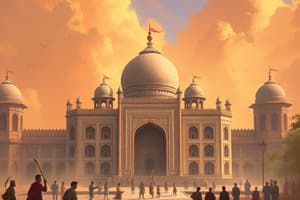Podcast
Questions and Answers
Who founded the Mughal Empire?
Who founded the Mughal Empire?
- Akbar
- Aurangzeb
- Humayun
- Babur (correct)
During which ruler's reign did the Mughal Empire reach its zenith?
During which ruler's reign did the Mughal Empire reach its zenith?
- Humayun
- Jahangir
- Shah Jahan
- Akbar (correct)
What was the Mughal court known for fostering?
What was the Mughal court known for fostering?
- Economic isolation
- Religious intolerance
- Cultural fusion (correct)
- Military conquests
Which of the following languages was created during the Mughal Empire's era of multiculturalism?
Which of the following languages was created during the Mughal Empire's era of multiculturalism?
Which region did the Mughal Empire encompass during its peak under Akbar?
Which region did the Mughal Empire encompass during its peak under Akbar?
Which dynasty was Babur a descendant of?
Which dynasty was Babur a descendant of?
What was the Mughal Empire known for integrating into their architecture?
What was the Mughal Empire known for integrating into their architecture?
Which Mughal emperor's policy promoted harmony among different religions?
Which Mughal emperor's policy promoted harmony among different religions?
What marked a turning point for the Mughal Empire's decline?
What marked a turning point for the Mughal Empire's decline?
What contributed to the decline of the Mughal Empire?
What contributed to the decline of the Mughal Empire?
Which architectural elements reflect Indian influences in Mughal architecture?
Which architectural elements reflect Indian influences in Mughal architecture?
What was a significant factor contributing to the emergence of regional potentates during the decline of the Mughal Empire?
What was a significant factor contributing to the emergence of regional potentates during the decline of the Mughal Empire?
Study Notes
The Mughal Empire
The Mughal Empire, a magnificent chapter in South Asian history, emerged in the early 16th century, transforming the Indian subcontinent with its unique blend of conquest, culture, and architecture. Founded by Babur, a descendant of the legendary Timurid dynasty, this powerful empire expanded rapidly, defining the golden age of India, and leaving an indelible mark on the region's history.
Mughal Empire's Expansion
The Mughals, initially a Central Asian tribe, migrated to the Indian subcontinent, their reign beginning with Babur's succession of the Kingdom of Delhi in 1526. The empire grew under the leadership of Babur's sons, Humayun and Akbar, and reached its zenith under the rule of Akbar, who expanded the empire's territories to encompass much of the Indian subcontinent, from present-day Afghanistan to the Bay of Bengal.
Culture and Society of the Mughal Empire
The Mughal Empire united diverse ethnic, linguistic, and religious groups, fostering an era of creative fusion. The Mughal court was a bastion of artistic and intellectual creativity, where scholars, artists, and craftsmen from various backgrounds came together to exchange ideas and develop unique forms of expression.
Confidence in their multiculturalism led to the creation of a new language, Dakhani, a blend of Persian and local languages. Mughal architecture and art reflected this synthesis of cultures, as evidenced in the Taj Mahal, the Red Fort, and the Humayun's Tomb, with their seamless integration of Indian and Persian architectural styles.
The Mughal Empire's embrace of a variety of religious traditions also fostered a culture of tolerance and inclusion. Akbar's policy of Sulh-i-Kul (universal peace) and Ijtihad (independent reasoning) promoted harmony among different religions, allowing for the growth of a flourishing spiritual atmosphere.
Decline of the Mughal Empire
Despite its initial success, the Mughal Empire faced multiple challenges, including political instability, military defeat, and economic decline. The empire's weakening grip on power led to the emergence of regional potentates, such as the Marathas and the Sikhs, who chipped away at the empire's territorial holdings.
The death of Aurangzeb, the last great Mughal emperor, in 1707, marked a turning point for the empire. The ensuing power vacuum resulted in the rise of regional factions, which further weakened the empire's central authority. This decline was accelerated by ineffective governance, economic mismanagement, and a lack of adaptability to changing circumstances.
Architecture of the Mughal Empire
The Mughal Empire's unique architectural style remains one of its most enduring legacies. Mughal architecture seamlessly combined Indian and Persian elements, resulting in magnificent structures such as the Taj Mahal, Red Fort, and Humayun's Tomb.
Mughal architecture featured red sandstone and white marble, with intricate carvings, geometric patterns, and naturalistic motifs. The use of domes, arches, and chhatris (small pavilions) reflected Indian influences, while the garden layouts and water features highlighted Persian influences.
In conclusion, the Mughal Empire's impact on the Indian subcontinent is inextricably linked to its cultural, architectural, and societal achievements. While the empire's decline was ultimately inevitable, its legacy continues to inspire and captivate generations of scholars, artists, and history enthusiasts.
Studying That Suits You
Use AI to generate personalized quizzes and flashcards to suit your learning preferences.
Description
Explore the rise, zenith, cultural fusion, decline, and architectural marvels of the Mughal Empire in South Asian history. Learn about the key emperors, societal contributions, and enduring impact on the Indian subcontinent.




